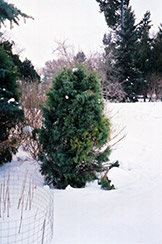Blue Redcedar
Juniperus virginiana 'Glauca'
Height: 20 feet
Spread: 12 feet
Sunlight:
![]()
Hardiness Zone: 4
Description:
A version of the native species with excellent blue foliage which fades to a greener blue over the season, upright oval to pyramidal habit of growth; can grow quite large, best used for articulation or as a color accent in the landscape; needs full sun
Ornamental Features
Blue Redcedar is primarily grown for its highly ornamental fruit. It features an abundance of magnificent silvery blue berries from late spring to late winter. It has attractive blue evergreen foliage which emerges silvery blue in spring. The scale-like sprays of foliage are highly ornamental and remain blue throughout the winter.
Landscape Attributes
Blue Redcedar is a multi-stemmed evergreen tree with a distinctive and refined pyramidal form. It lends an extremely fine and delicate texture to the landscape composition which can make it a great accent feature on this basis alone.
This tree will require occasional maintenance and upkeep, and is best pruned in late winter once the threat of extreme cold has passed. Deer don't particularly care for this plant and will usually leave it alone in favor of tastier treats. Gardeners should be aware of the following characteristic(s) that may warrant special consideration;
- Disease
Blue Redcedar is recommended for the following landscape applications;
- Accent
- Vertical Accent
Planting & Growing
Blue Redcedar will grow to be about 20 feet tall at maturity, with a spread of 12 feet. It has a low canopy, and is suitable for planting under power lines. It grows at a medium rate, and under ideal conditions can be expected to live for 70 years or more.
This tree should only be grown in full sunlight. It is very adaptable to both dry and moist growing conditions, but will not tolerate any standing water. It is considered to be drought-tolerant, and thus makes an ideal choice for xeriscaping or the moisture-conserving landscape. It is not particular as to soil type or pH. It is highly tolerant of urban pollution and will even thrive in inner city environments. This is a selection of a native North American species.
